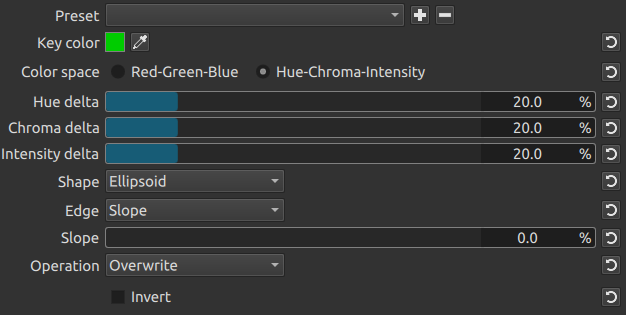This filter makes certain colors of your video transparent. Thus, you need to have something under the video to see its effect. You can also use it after a Mask filter and before Mask: Apply if you want to make other filters affect only certain colors, for example for secondary color correction.

Key color
This is the color to select. This is the center point of the selected color subspace. You can use the dropper to pick a color from the screen. When using the dropper, drag a small rectangle to average the color values within the rectangle.
Color space
This specifies in which of the two color spaces (RGB, HCI) the delta controls will work. HCI is separated luma/chroma (a cylindrical “Hue Chromacity Intensity”) space. It suffers from chroma subsampling, and will give less sharp results than RGB.
NOTE: Chroma subsampling is not a fault of this plugin. Frei0r plugins work in RGB 4:4:4. If you supply it with a truly 4:4:4 video, it will produce perfectly sharp alpha from both color spaces.
NOTE: HCI is slow, because it has to calculate the arctangent and hypotenuse for each pixel.
Red/Green/Blue delta
Hue/Chroma/Intensity delta
These three parameters determine the size of the color subspace along each axis. Bigger value means bigger tolerance on that axis. For example, setting a high intensity delta (in HCI), will allow the selection of a specific color in both light and shadows, but will also discard most of the high-bandwidth luma signal, making the selection less spatially accurate.
Shape
This determines the shape of the color subspace. Options are: Box, Ellipsoid or Diamond. Box is the biggest of them (by volume) and diamond the smallest. Imagine an octahedron inscribed inside an ellipsoid, which is in turn inscribed in a box. The tips of the diamond touch the ellipsoid, and the box, at the center of the sides of the box.
Edge
This has five options: Hard, Fat, Normal, Thin and Slope. Hard means the alpha channel will be thresholded to two values only, fully opaque and fully transparent. This is mainly useful for keying. The Slope mode is also intended for keying. It is particularly useful when keying partly transparent or fuzzy (like hair) objects. The remaining options (Fat, Normal and Thin) create a gradual transition between transparent and opaque. Alpha will be a function of the difference of color from the selected color, with cutoff at the delta points.The fatter the choice, the more the selected areas are filled towards the rim. This is useful with alpha controlled color adjustment tools.
Slope
When edge mode is set to Slope, this parameter controls a gradual transition between opaque and transparent. 0% gives a hard-edged key, increasing the value of this parameter increases the range of colors around the selected color, that will be rendered partially transparent.
Operation
This determines the way in which the alpha channel will be written. These options combine the current selection with the pre-existing alpha of the source material. This way complex selections can be built. The Minimum, Maximum, Add and Subtract options allow cascading of other Alpha Channel or Mask filters; Overwrite does not.
Invert
When ON, the selected color will be transparent, as normally used with keying. When OFF (default) the selected color will be opaque, for example for alpha controlled adjustment of that color only.